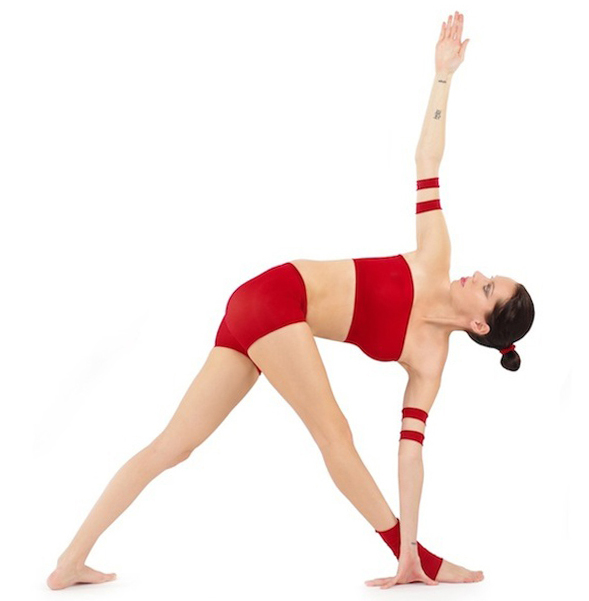Drishti (Yoga) on:
[Wikipedia]
[Google]
[Amazon]
Drishti ( sa, दृष्टि, translit=dṛṣṭi; ), or focused gaze, is a means for developing concentrated intention. It relates to the fifth limb of yoga,
 Each
Each
pratyahara Pratyahara () or the 'gathering towards' is the fifth element among the Eight stages of Patanjali's Ashtanga Yoga, as mentioned in his classical work, ''Yoga Sutras of Patanjali'' composed in the 2nd century BCE. It is also the first stage of the ...
, concerning sense withdrawal, as well as the sixth limb, dharana, relating to concentration.
In Ashtanga Vinyasa Yoga, each asana
An asana is a body posture, originally and still a general term for a sitting meditation pose,Verse 46, chapter II, "Patanjali Yoga sutras" by Swami Prabhavananda, published by the Sri Ramakrishna Math p. 111 and later extended in hatha yoga ...
is associated with one of the 8 focused gazes, namely Angusthamadhye (thumb), Bhrumadhye (eyebrow), Nasagre (tip of nose), Hastagrahe (tips of hands), Parshva (side), Urdhva (up), Nabhicakre (navel), and Padayoragre (tips of feet) Drishtis. In some other styles such as Sivananda Yoga, less use is made of the gaze, and fewer types are employed.
History
The ''Yoga Sutras of Patanjali
The ''Yoga Sutras of Patañjali'' is a collection of Sanskrit sutras (aphorisms) on the theory and practice of yoga – 195 sutras (according to Vyāsa and Krishnamacharya) and 196 sutras (according to others, including BKS Iyengar). The ' ...
'' define eight limbs of yoga
Ashtanga yoga (, "the eight limbs of yoga") is Patanjali's classification of classical yoga, as set out in his ''Yoga Sutras''. He defined the eight limbs as yamas (abstinences), niyama (observances), asana (postures), pranayama (breathing), prat ...
but do not mention the gaze. The sixth limb, dharana (concentration), however requires holding one's mind onto an inner state, subject or topic. The mind can for example be fixed on a mantra
A mantra (Pali: ''manta'') or mantram (मन्त्रम्) is a sacred utterance, a numinous sound, a syllable, word or phonemes, or group of words in Sanskrit, Pali and other languages believed by practitioners to have religious, ma ...
, one's breath, or a part of the body such as the navel or the tip of the tongue. This is an internal concentration of attention, not a gaze.
In the ''Bhagavad Gita
The Bhagavad Gita (; sa, श्रीमद्भगवद्गीता, lit=The Song by God, translit=śrīmadbhagavadgītā;), often referred to as the Gita (), is a 700- verse Hindu scripture that is part of the epic ''Mahabharata'' (c ...
'' VI.13, Krishna
Krishna (; sa, कृष्ण ) is a major deity in Hinduism. He is worshipped as the eighth avatar of Vishnu and also as the Supreme god in his own right. He is the god of protection, compassion, tenderness, and love; and is one ...
instructs the hero Arjuna
Arjuna (Sanskrit: अर्जुन, ), also known as Partha and Dhananjaya, is a character in several ancient Hindu texts, and specifically one of the major characters of the Indian epic Mahabharata. In the epic, he is the third among Panda ...
to "hold one's body and head erect in a straight line and stare steadily at the tip of the nose".
The 1737 ''Joga Pradīpikā
The ''Joga Pradīpikā'' (जोगप्रदीपिका, "A Small Light on Yoga") is a hatha yoga text by Ramanandi Jayatarama written in 1737 in a mixture of Hindi, Braj Bhasa, Khari Boli and forms close to Sanskrit. It presents 6 cleansi ...
'' uses the same two Drishtis, Nasagre and Bhrumadhye, requiring their use with each of the 84 asanas described in the text.
Modern
Styles of modernyoga as exercise
Yoga as exercise is a physical activity consisting mainly of postures, often connected by flowing sequences, sometimes accompanied by breathing exercises, and frequently ending with relaxation lying down or meditation. Yoga in this form has ...
such as Ashtanga Vinyasa Yoga, Iyengar Yoga and Sivananda Yoga make differing uses of Drishtis.
In Ashtanga Vinyasa Yoga
 Each
Each asana
An asana is a body posture, originally and still a general term for a sitting meditation pose,Verse 46, chapter II, "Patanjali Yoga sutras" by Swami Prabhavananda, published by the Sri Ramakrishna Math p. 111 and later extended in hatha yoga ...
is associated in Ashtanga Vinyasa Yoga with a particular Drishti. There are eight Drishtis (counting the paired Parshva Drishtis on the left and right sides as one).
In Iyengar Yoga
Iyengar Yoga rarely speaks of Drishtis, but in its instructions for some asanas it tells the practitioner to look in a certain direction, for example upwards inTrikonasana
Trikonasana or Utthita Trikonasana ( sa, उत्थित त्रिकोणासन; IAST: ''utthita trikoṇāsana''), xtendedTriangle Pose is a standing asana in modern yoga as exercise. Variations include Baddha Trikonasana (bound tri ...
and forwards in Virabhadrasana II.
In Sivananda Yoga
Sivananda Yoga makes use of two Drishtis, namely Nāsāgre and Bhrūmadhye, for tratak exercise ( a purification) rather than in asana practice. Vishnudevananda cautions that prolonged or incorrect practice may cause problems for the eye muscles or nervous system. Initial practice is often done for only minutes at a time, but is gradually increased to up to ten minute intervals.References
Sources
* * * * * * * * * * * {{Yoga Hatha yoga Yoga concepts